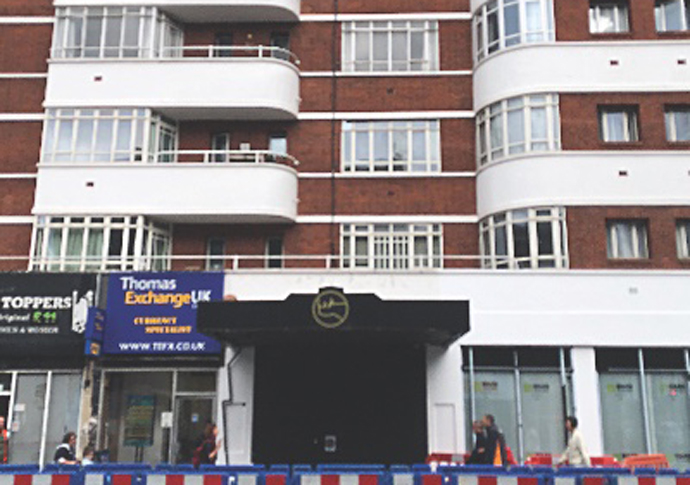Paramount importance!
Our ‘Untold London’ historian Dan Carrier reflects on a dancehall with a difference
Friday, 11th October 2024 — By Dan Carrier

TODAY, the front door is closed and rubbish has collected in the doorway.
The last incarnation was as a so-called “Gentleman’s Club” – Spearmint Rhino –but the Tottenham Court Road venue has now been shut for five years.
Nearly 100 years ago, this space in the basement of a block built between the wars was a packed out dancehall, and was one of the first back-owned venues in London.
It meant two things: the bands did not face the usual racist employment conditions, and there was no racist door policy.
It meant band leaders wanted to play there and give their best – and the crowded dance floor let people cut some moves after a tough working week.
Sadly, the club’s success would lead to its downfall: by 1950, the dancefloor of The Paramount had gone quiet due to a scandalised press looking for an easy headline and police officers looking for heads to crack on a Saturday night.
The Paramount had been taken on by a Jamaican émigré in the mid-1930s, and between the wars it was one of what historian Lloyd Bradley called a “remarkable” number of black-owned venues. In Soho, there was The Caribbean in Denholm Street, The Nest in Kingly Street, and The Fullardo in Carnaby Street.
All were good, but The Paramount was known for its innovation and the place where jazz became jump-jive and the jitterbug.
It was seen as an upmarket place, with crowds of well dressed working-class black Londoners, joined by servicemen, sailors, African students and musicians on a night off.
As Lloyd Bradley noted, it was made up of “black folks who had probably had enough of white people for that week and wanted nothing more on Friday or Saturday night than to relax with people who looked like them”.
Its entertainment policy also made it a draw. It had a Caribbean slant in its musical programming, rather than the jazz dance standards shaped by New York. The owner believed if someone had paid a two shilling door fee, he would give them half a crown of entertainment.
It was a place to showcase music from across Africa and the Caribbean: Ghanaian highlife maestro ET Mensah visited the Paramount and was so impressed by what he heard he named his club in Accra after it.
At first, the clientele were mainly Caribbean workers, though they would be joined by white Irish and Jewish labourers.
The club sold sandwiches and tea as well as alcohol, and many West End workers who faced issues over travelling home late at night – or had issues with lodgings – could enter The Paramount, have a bite to eat and then curl up in a corner and get a few hours’ rest before heading back to work.
It kept them from sheltering in shop doorways, where they were at risk of assault or arrest.
During the Second World War, 130,000 black GIs passed through London between 1942 and 1945. Many found comfort under the dimmed Paramount lights. There was pressure on the management to beef up their door policy.
The no entry excuse of having to wear a tie to get in prompted some to rock up wearing the ugliest, most outrageous tie they could find.
Bouncers changed their tactics – a new rule said men must be accompanied by a woman. Women – both black and white – broke this wheeze by waiting in the foyers for their “partner” to arrive, and then shepherd in those being discriminated against.
It wasn’t always plain sailing: regular Enrico Stennett recalled feeling one partner running her hand up and down his back. He thought it was a little forward until he discovered she shockingly believed black people had tails, and was searching for his.
The police were never far away. In November 1941, they swooped. The Daily News had been tipped off, and under a headline “Search for Shirkers,” described police scouring The Paramount.
“Guards were placed at all exits and dancing stopped while civilians’ identity cards and Service leave passes were checked,” its article said.
Genuine absconders would have been foolish to think a night at The Paramount might be relaxing.
Police raids continued even through the war. The Daily News covered another in October 1943 where over 1,000 men were lined up to have their identity papers checked.
Every weekend, officers would be gathered outside the Roebuck Public House opposite the club.
They would try to provoke trouble. One trick was to wait outside the club and when a black man emerged with a woman on his arm, trip the couple up.
Before either knew it, they were arrested on trumped up charges such as breaching the peace, obstruction or even assault.
Some of those enjoying a night out were savvy to the trouble waiting for them outside and would arrange to exit separately with their date and meet on the platform of Warren Street station.
White gangs also cruised the area, looking for trouble.
Mr Stennett recalled witnessing one such assault: he saw three black men and three white woman go to a café after leaving The Paramount. A gang stormed in, dragged the three men out and battered them. The witness was so worried they called the police, who promptly let the attackers saunter off and arrested the three black men.
Because of its success, it made a lot of enemies. From racist police to pontificating moral commentators, to jealous venue owners and newspapers looking for an easy headline, The Paramount became the unfortunate focus of what today would be called a trumped-up culture war.
The end came in 1950.
After one police raid, which saw the orchestra arrested and then later released with no charge, the music stopped for good.
The Paramount was turned into a banqueting hall and this unconscious beacon of equality fell silent for good.